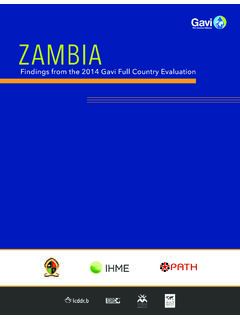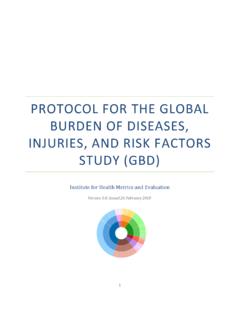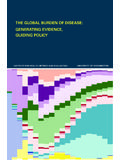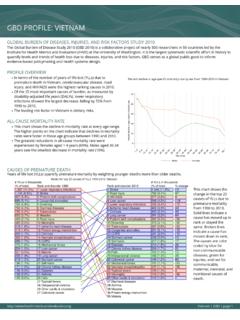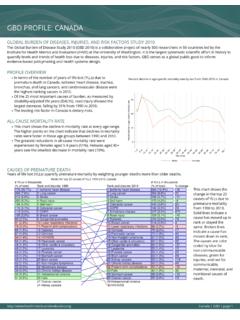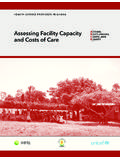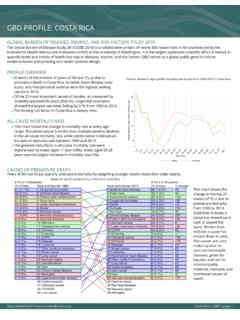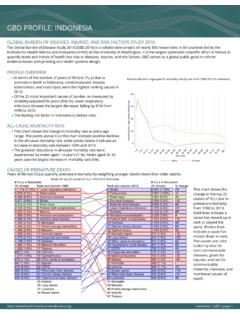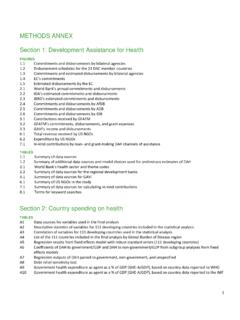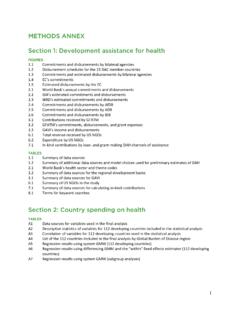Transcription of GBD 2016 Online Tools Overview - Health Data
1 GBD 2016 Online Tools Overview September 2017. Preface This document is a basic guide to the suite of web based Tools for the global burden of disease Study (GBD). These Tools allow students, researchers, policymakers, and the public to view and interact with results from GBD. They are all freely available for non commercial use. This guide touches on the global Health Data Exchange (GHDx) data catalogue and the code used to generate GBD results, but its primary focus is on the Tools which allow users to query, view, and download, in CSV format, the following: Data input sources (lists of the raw data sources used to produce estimates for different components of the study, and relevant metadata about them). Model input data (data points adjusted to meet GBD's format and quality requirements). Estimates (final GBD results: the point estimates and 95% uncertainty intervals, where appropriate, for study indicators).
2 These Tools are the GBD Results tool , GBD Compare, Mortality Visualization (MortViz), Causes of Death Visualization (CoDViz), Epi Visualization, (EpiViz), and GBD Data Input Sources tool . This guide offers definitions for the indicators (or measures ) and other dimensions of the data available in them and an Overview of what data users can expect to view and download from each. Lists of numeric IDs and standardized names are provided for the values in each dimension, as is a table of the measures for which estimates were produced by GBD cause. Additional data resources for GBD 2016 are available at Information on the GBD study is available at Contact Us Do you have questions or comments about any of the GBD 2016 Online Tools ? Email us at Call us at +1 206 897 2800. Fax us at +1 206 897 2899. Write us at Institute for Health Metrics and Evaluation 2301 Fifth Ave., Suite 600. Seattle, WA 98121.
3 USA. GBD 2016 Online Tools Overview 2. Contents Preface .. 2. Contact Us .. 2. Section 1: tool 4. GBD Results tool .. 4. GBD Compare .. 4. Mortality Visualization (MortViz) .. 5. Causes of Death Visualization (CoDViz) .. 5. Epi Visualization (EpiViz) .. 6. Data Input Sources tool .. 6. GHDx .. 7. Code .. 7. Section 2: Term 8. Section 3: tool Outputs and Indicators Overview .. 11. Section 4: Dimension Values .. 13. Age Group .. 13. Cause .. 14. 21. Impairment .. 22. Location .. 23. Measure .. 33. Model (EpiViz) .. 34. Risk .. 62. Sex .. 64. Section 5: Causes by Measure .. 64. GBD 2016 Online Tools Overview 3. Section 1: tool Descriptions GBD Results tool The GBD Results tool allows the user to query and download in a CSV file the indicators from the most recently published annual GBD. Users can select a specific subset of results according to different dimensions including indicator, cause, risk, location, age, and year.
4 Figure 1. GBD Results tool The GBD Results tool is found here: results tool . GBD Compare GBD Compare allows users to analyze the world's Health levels and trends in the most recent set of annually published results. Users can use maps, plots, treemaps, arrow diagrams, and a dozen other charts to compare patterns and trends in causes and risks over time, to explore the Health profile within a country by age and sex; to compare countries with one another; or to explore regional or global trends. Users can drill from a global view into country views including subnational details for some countries; can examine how disease patterns have changed over time; and can explore which causes of death and disability are increasing and which are decreasing. GBD Compare is the GBD's most comprehensive visualization, displaying data from the widest range of GBD components. Figure 2. GBD Compare GBD Compare is found here: 34T 34T.
5 GBD 2016 Online Tools Overview 4. Mortality Visualization (MortViz). The Mortality Visualization (MortViz) allows users to view data and indicators of all cause mortality. Users are able to follow each analytic step from the beginning of the data preparation to the final results and each transformation along the way. The visualization provides views of both child mortality (defined as the probability of dying between birth and age 5) and adult mortality (defined as the probability of dying between age 15 and 60) for each of the locations for which indicators are produced for the annual global GBD enterprise. Figure 3. MortViz MortViz is found here: Causes of Death Visualization (CoDViz). The Causes of Death (CodViz) allows users to view data and estimates of death by cause, age, sex, and location over time. Deaths are represented as rates, cause fractions ( , the proportion of total deaths due to a cause), and numbers.
6 Users have the ability to see the transformations of the input data to correct for different biases and to see the effects of garbage code redistribution. They also have access to the model parameters that were used to generate results for a given cause. Figure 4. CoDViz CodViz is found here: GBD 2016 Online Tools Overview 5. Epi Visualization (EpiViz). The Epi Visualization (EpiViz) allows users to view data from the nonfatal Health outcomes component of the GBD. It allows users to see the input data, data corrections, model settings and results of prevalence, incidence, remission, excess mortality and cause-specific mortality rates for each of the diseases and risk factors that have been analyzed in the GBD. Figure 5. EpiViz EpiViz is found here: Data Input Sources tool The Data Input Sources tool allows users to view citations for sources of data by cause, location, and year for the most recently published set of annual results.
7 For example, users can search for all sources associated with a particular cause and location and retrieve a set of citations used by GBD to produce those indicators. The tool 's CSV export function also provides the complete set of dimensions and metadata associated with that source. Figure 6. GBD Data Input Sources tool The Data Input Sources tool is found here: GBD 2016 Online Tools Overview 6. GHDx The global Health Data Exchange (GHDx) is a catalogue of data sources related to Health . It includes citations for all sources used in the most recent version of the annually published GBD. (It also includes sources that are not included in or relevant to the GBD, but are Health related and may be of use to other research.) Users can perform searches based upon keyword, location, data type, and year. Full citation information is provided for all sources. Wherever possible, links are provided to the data contained in each source.
8 Where data holders prohibit direct access to the data without further registration or request, links are provided to the relevant instructions. Figure 7. GHDx The GHDx is found here: Code Starting with the 2015 study, GBD publishes its analytic code in concordance with the GATHER. guidelines. Code is found here: GBD 2016 Online Tools Overview 7. Section 2: Term Definitions Term Definition Age group A population segment within a specified age range. All-cause mortality rate The number of deaths due to all conditions by the mid-year population. A single disease or injury or an aggregation of diseases and injuries that Cause causes death or disability. The classification of diseases and injuries. The causes in GBD are classified into 4 levels. At level 1, there are three large cause groupings: communicable, maternal and neonatal conditions and nutritional deficiencies (CMNN); non-communicable diseases (NCDs); and injuries.
9 At level 2 there are 21 disease and injury categories. The finest level of detail Cause hierarchy in causes is provided at levels 3 and 4. Cause-specific mortality Rate The number of deaths due to cause divided by the mid-year population. Continuous variable A population characteristic that is measured on a continuous scale ( , the mean level of blood pressure or body mass index). Deaths Deaths occurring in a population during a certain time period. Disability-adjusted life The sum of years lost due to premature death (YLLs) and years lived with years (DALYs) disability (YLDs). DALYs are also defined as years of healthy life lost. The cause, set of causes, or manner of causation of a disease or condition. For example, diarrhea is a cause in the GBD. Diarrhea itself has many Etiology causes (like norovirus). Diarrhea is the cause; norovirus is the etiology. The number of excess deaths divided by the number of prevalent cases.
10 It Excess mortality rate is equivalent to the cause-specific mortality rate divided by prevalence. Expected value (life The value of a specified measure (life expectancy, deaths, YLLs, YLDs, or expectancy, deaths, DALYs) that is expected for a particular GBD location and year, given its YLLs, YLDs, DALYs) socio-demographic development status as measured by SDI. An increase in the death rate of more than 1 per million, resulting from conflict and terrorism, natural disasters, major transport accidents or Fatal discontinuities epidemics. A summary measure of personal Health care access and quality for a given location. HAQ is based on risk-standardized mortality rates from causes Healthcare Access and that, in the presence of high-quality Health care, should not result in death Quality Index (HAQ) also known as amenable mortality. Healthy life expectancy, The number of years that a person at a given age can expect to live in good or Health -adjusted life Health , if the rates of all-cause mortality and all-cause disability in a expectancy (HALE) specified year of interest would remain constant into the future.
